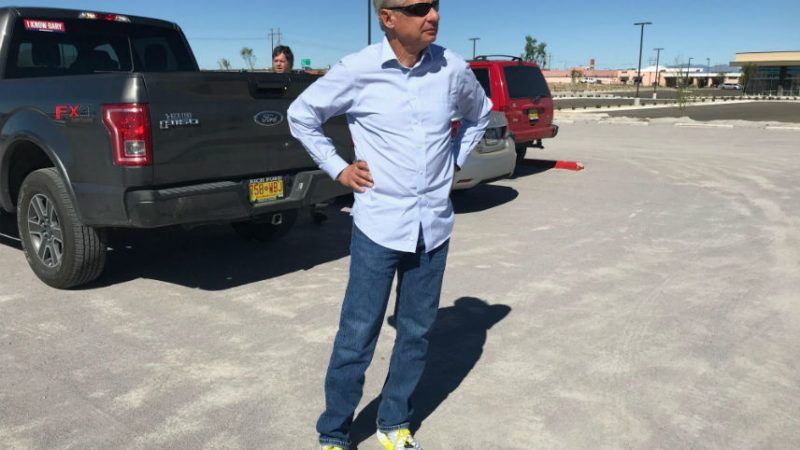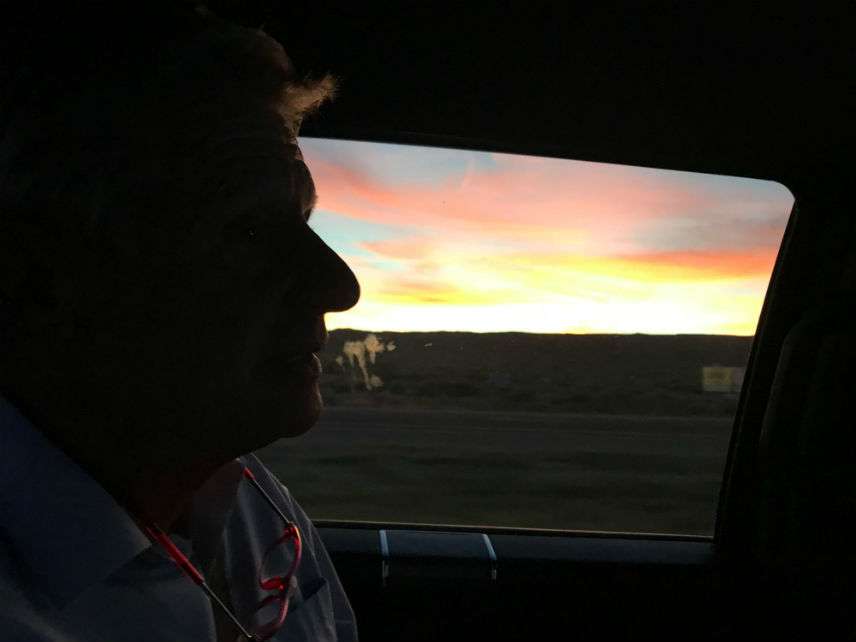Is the Libertarian Party Glass Half Full or Half Empty?
Party activists reflect after both a disappointing midterm and an energizing Jeff Hewitt win


Last Friday, after a lengthy ballot count, Libertarian Jeff Hewitt was declared the winner of one of five officially nonpartisan seats on the Riverside County Board of Supervisors, giving him one of the largest constituent bases of any elected Libertarian in the party's 47-year history. On Saturday in this space, we posted a far less upbeat assessment of the L.P.'s current electoral situation, which I wrote the day after the 2018 midterms.
So is the party zigging or zagging? As ever, it depends on who you ask, and the answer may well be "both."
In a teleconference with party activists before the Hewitt announcement last week, Libertarian National Committee Chair Nicholas Sarwark laid out the numerical case for optimism.
"We ran 833 candidates for public office in 2018 in the November elections. We ended up with 52 [now 53] elected Libertarians….That's an increase from the last general election year 2016, where we only elected 34 people," said Sarwark, who finished in fourth and last place in November's Phoenix mayoral race, receiving 10.5 percent of the vote. "In 2016, the Libertarian Party ran 593 candidates around the country….2017's our last odd-numbered year; we ran 135 candidates for both state and local races, but of those, we ended up electing 48. So we do significantly better in these odd-year elections when the old parties aren't paying as much attention. And it gives us a chance to further hone those skills and strategies so that when we go into 2020, we're ready to have a record-setting number of candidates for a presidential year, and have more of them be more successful."
In a press release Friday, the party exulted over Hewitt's win, calling it "arguably the largest, most momentous win in Libertarian Party history." The release went on to list the other winners from November, including four municipal officials who won partisan races in Indiana.
Mark Rutherford, a longtime activist in the comparatively successful Indiana L.P., and former vice chair of the national party (2010-12), says there has a been a sea change in approach to nuts-and-bolts campaigning. "I've never seen canvassing taken so serious by Libertarians since I first started paying serious attention to the LP in 1994," Rutherford wrote in an email to me this week.
"More and more insider meetings and discussions center around running for office locally, especially smaller districts with 2000 or fewer voters," Rutherford continued. "In 1998 it was hard to get LP'ers to talk about anything other than Presidential candidates and Congressional candidates….Too many discussion[s] were akin to philosophical debates over whether Hayek, Nock, or Rand were the most holy."
Bottom line: "Right now, change is happening in the LP as I see it becoming a party that finds libertarians and gets them elected or appointed to office. I hope it continues."
But other Libertarians look at the same data and discern drastically different meaning.

Arvin Vohra, the rhetorical bomb-thrower and former national vice chair (2012-16) who is running for the party's 2020 presidential nomination, wrote a withering assessment right after the election arguing that the disappointing results, especially of New York gubernatorial candidate Larry Sharpe, show that the L.P. can only go so far playing it safe.
"I get why many Libertarians like Larry, Nick Sarwark, and other nice Libertarians," Vohra wrote. "Many people used to like me for the same reason, back when I used to play nice. You can bring Larry or Nick home to meet your statist mom, or your statist friends. That's something I like about Larry and Nick—I can bring them home to my statist friends. I get why some big-L insiders don't like me. You can't bring me home to meet your statist mom. If you come home with me, you're getting disowned."
Vohra's solution? Fight directly and conspicuously for those who are net contributors to, instead of recipients from, government, and also to those whose power is diminished by the state.
"Winning will come from fighting for the reality we want, and emboldening those who will benefit from that Libertarian reality immediately. We have to fight for our people before we pander to our enemies," he concluded. "If you add the number of current homeschoolers, private schoolers, and Men's Rights Activists, it's far more than the 4 million [votes 2016 presidential candidate Gary Johnson] got. Add in those who pay more in taxes than they receive in services, and it's many, many times that. Even if I get 10 percent of the net losers from government, it will shatter Gary Johnson's record."
Vohra's approach did not translate into votes last month in Maryland, where he finished in a distant fourth place with just 1.0 percent of the vote running for U.S. Senate.
Vohra will be among what promises to be a crowded field vying for the party's prized plum: access to ballots in the 2020 presidential race. Those who have officially announced their intentions to compete include confrontational activist Adam Kokesh, political performance artist Vermin Supreme, and L.P. Radical Caucus Vice Chair Kim Ruff. Also openly laying the groundwork is controversial 2016 vice presidential candidate Bill Weld. Overstock.com founder and blockchain enthusiast Patrick Byrne has engaged in some discussions, though told me in October that he's "almost definitely" not going to run.
"And then there are a few more people who have contacted me privately to ask questions about what would one do and how do you do it," Sarwark said in his conference call. Party insiders have presumed that among such names to eventually go public will be current or recent elected officials from one of the two major parties, though such hopes have failed to materialize in the past.
How tantalizing is the L.P. ballot prize? "As far as how we came out of the 2018 election, ballot access-wise," Sarwark said, "we are on in 34 states for 2020 for a presidential candidate. That is the best situation we have ever been in after a non-presidential general election, and it's actually the best situation that any third party has been in in history." The party maintains its expectation to be on the ballot in all 50 states plus the District of Columbia, "which would be one of the first times, maybe the first time, that anyone's done that back to back as a non-Republican-or-Democratic party."
The biggest nut to crack—not just for Libertarians, but for Greens and independents as well—may well be how to navigate electoral politics when the winds of polarization are blowing so strong. Voters who perceive elections as life-or-death contests tend to shun the margins.
Still, as the L.P. celebrates its 47th anniversary this week, there are measurable signs of progress, if not quite the whole free-society-in-our-lifetimes thing, or even a member of Congress.
"The original Libertarian Party had only 70 members, but today exceeds 130,000," the L.P. noted yesterday in a birthday press release. "The membership of the Libertarian Party has increased by 92 percent during the past 10 years. The presidential ticket of Gov. Gary Johnson and Gov. William Weld in 2016 received a record number of votes for the Libertarian Party. Perhaps most importantly, the Libertarians are the only party on the political spectrum defending both economic responsibility and social acceptance."
Bonus video: Todd Krainin captures the final days of Gary Johnson's final campaign.
Show Comments (86)